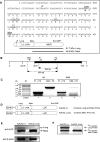Differential use of an in-frame translation initiation codon regulates human mu opioid receptor (OPRM1)
- PMID: 19609488
- PMCID: PMC11115551
- DOI: 10.1007/s00018-009-0082-7
Differential use of an in-frame translation initiation codon regulates human mu opioid receptor (OPRM1)
Abstract
The pharmacological effects of morphine and morphine-like drugs are mediated primarily through the micro opioid receptor. Here we show that differential use of an in-frame translational start codon in the 5'-untranslated region of the OPRM1 generates different translational products in vivo and in vitro. The 5'-end of the OPRM1 gene is necessary for initiating the alternate form and for subsequent degradation of the protein. Initiation of OPRM1 at the upstream site decreases the initiation at the main AUG site. However, alternative initiation of the long form of OPRM1 produces a protein with a short half-life, resulting from degradation mediated by the ubiquitin-proteasome pathway. Reporter and degradation assays showed that mutations of this long form at the second and third lysines reduce ubiquitin-dependent proteasome degradation, stabilizing the protein. The data suggest that MOP expression is controlled in part by initiation of the long form of MOP at the alternate site.
Figures





Similar articles
-
uAUG-mediated translational initiations are responsible for human mu opioid receptor gene expression.J Cell Mol Med. 2010 May;14(5):1113-24. doi: 10.1111/j.1582-4934.2009.00734.x. Epub 2009 Mar 6. J Cell Mol Med. 2010. PMID: 19438807 Free PMC article.
-
Efficient translation initiation directed by the 900-nucleotide-long and GC-rich 5' untranslated region of the human retrotransposon LINE-1 mRNA is strictly cap dependent rather than internal ribosome entry site mediated.Mol Cell Biol. 2007 Jul;27(13):4685-97. doi: 10.1128/MCB.02138-06. Epub 2007 Apr 30. Mol Cell Biol. 2007. PMID: 17470553 Free PMC article.
-
Translational regulation of the JunD messenger RNA.J Biol Chem. 2002 Sep 6;277(36):32697-705. doi: 10.1074/jbc.M204553200. Epub 2002 Jun 24. J Biol Chem. 2002. PMID: 12105216
-
The interplay between cis- and trans-acting factors drives selective mRNA translation initiation in eukaryotes.Biochimie. 2024 Feb;217:20-30. doi: 10.1016/j.biochi.2023.09.017. Epub 2023 Sep 21. Biochimie. 2024. PMID: 37741547 Review.
-
Pushing the limits of the scanning mechanism for initiation of translation.Gene. 2002 Oct 16;299(1-2):1-34. doi: 10.1016/s0378-1119(02)01056-9. Gene. 2002. PMID: 12459250 Free PMC article. Review.
Cited by
-
Up-regulation of the mu-opioid receptor gene is mediated through chromatin remodeling and transcriptional factors in differentiated neuronal cells.Mol Pharmacol. 2010 Jul;78(1):58-68. doi: 10.1124/mol.110.064311. Epub 2010 Apr 12. Mol Pharmacol. 2010. PMID: 20385708 Free PMC article.
-
Vimentin interacts with the 5'-untranslated region of mouse mu opioid receptor (MOR) and is required for post-transcriptional regulation.RNA Biol. 2013 Feb;10(2):256-66. doi: 10.4161/rna.23022. Epub 2013 Jan 25. RNA Biol. 2013. PMID: 23353576 Free PMC article.
-
Transcriptional and epigenetic regulation of opioid receptor genes: present and future.Annu Rev Pharmacol Toxicol. 2011;51:75-97. doi: 10.1146/annurev-pharmtox-010510-100605. Annu Rev Pharmacol Toxicol. 2011. PMID: 20868272 Free PMC article. Review.
-
Post-transcriptional regulation of mu-opioid receptor: role of the RNA-binding proteins heterogeneous nuclear ribonucleoprotein H1 and F.Cell Mol Life Sci. 2012 Feb;69(4):599-610. doi: 10.1007/s00018-011-0761-z. Epub 2011 Jul 8. Cell Mol Life Sci. 2012. PMID: 21739230 Free PMC article.
-
Epigenetic Modulation of Opioid Receptors by Drugs of Abuse.Int J Mol Sci. 2022 Oct 5;23(19):11804. doi: 10.3390/ijms231911804. Int J Mol Sci. 2022. PMID: 36233105 Free PMC article. Review.
References
Publication types
MeSH terms
Substances
Grants and funding
- R01 DA000564/DA/NIDA NIH HHS/United States
- P50 DA011806/DA/NIDA NIH HHS/United States
- R56 DA000564/DA/NIDA NIH HHS/United States
- DA011190/DA/NIDA NIH HHS/United States
- K02 DA013926/DA/NIDA NIH HHS/United States
- K05 DA070554/DA/NIDA NIH HHS/United States
- DA001583/DA/NIDA NIH HHS/United States
- DA011806/DA/NIDA NIH HHS/United States
- DA000564/DA/NIDA NIH HHS/United States
- R01 DA001583/DA/NIDA NIH HHS/United States
- DA013926/DA/NIDA NIH HHS/United States
- R01 DA011190/DA/NIDA NIH HHS/United States
- K05-DA070554/DA/NIDA NIH HHS/United States
LinkOut - more resources
Full Text Sources
Research Materials

